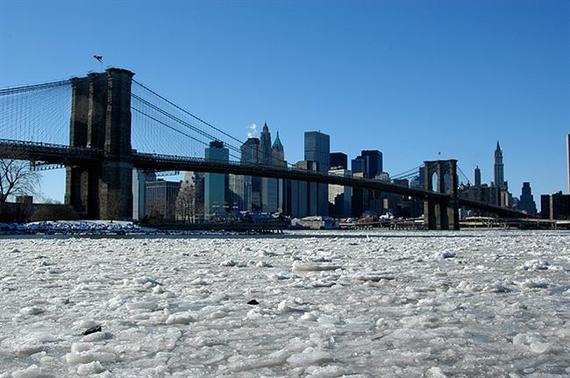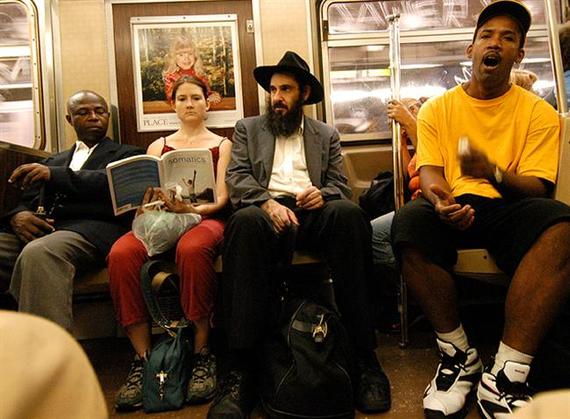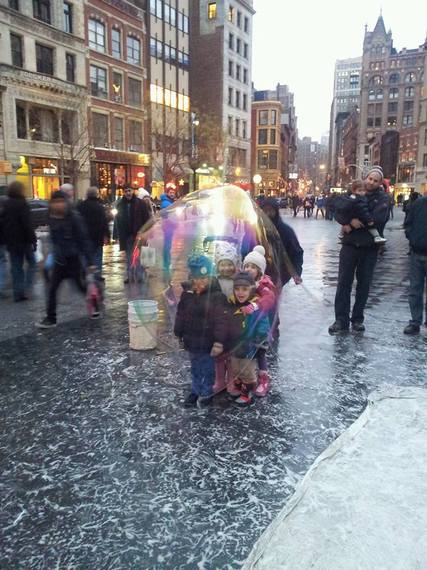
The Brooklyn Bridge after the winter snowstorm. Photo courtesy of Jeff Pappas photography. Visit his website. http://www.jeffpappas.com
New York City's most recent incarnation is characterized by a quality of defiance in its street artists and buskers, defiance through random acts of kindness; and in the deep communing of strangers on antiquated subway cars.
Last Monday, Edmond Leary dipped two long sticks tied with string into soapy water buckets; then pumped them in the air to create enormous iridescent bubbles.
The crowd was entranced by the magical spheres as they floated across Union Square. A homeless man catcalled. A child giggled. A business woman started to tear up. It was the first warm day in a week. The crowd's boots were soaked with dirty slush. Still, Leary had found a way to rekindle pure joy in them, relieving them of their winter depression.
Leary is a young African-American man who created "Share the Bubble Love" after losing his job. There was something about his expression and the way he worked the crowd that revealed his resilience, and the macabre humor one needs to hustle enough money to make rent. His ingenuity in finding a way to make street art out of string, sticks and soapy water mark him as a survivor.
Leary is one of the New York performers who also inadvertently functions as a modern-day faith healer in a city secretly scarred by poverty; discrepancy and in many places on the verge of collapse. From Alphabet City to West Harlem; multi-million dollar condos sit partially vacant in neighborhoods practically bereft of the ethnically and economically diverse populations that once lived there. Promises rock star developers made went unfulfilled, their mad money vanished.
The subway system creaks and groans, its arteries clogged like a man on the verge of a heart attack. "Work stoppages" crush travelers, one must be wily and outsmart the lines just to get home. Entire stations have been abandoned. Newscasters recently nicknamed the shuttered Cortland Street (below the World Trade Center) a "ghost station." The mole people who lived in the subterranean shantytown that once flourished in the defunct Amtrak station below Riverside Park were forced out. Brilliant graffiti by Chris "Freedom" Pape, honors their passage.
Other oddities exist. Cars with broken doors and grimy floors are plastered with incongruent posters advertising liposuction, butt enhancements, therapists you can visit exclusively through text message.
And there is something else, some amorphous quality of a world on the brink of a major shift that can be felt more intensely in this tightly wound metropolis.
The buskers below ground are the warriors---crooning song lines into tunnels, guiding lost travelers home. They are no longer overtly chased like they were in the 1990s when Giuliani's quality of life laws made busking (and selling Lucy's, barbequing, panhandling) a punishable crime. Still, they are furtive. Buskers have been arrested under De Blasio's watch.
This winter the feverish music has returned. No matter how frigid it is out, somebody is playing the violin, break dancing on cardboard, beating snare drums, belting out hymns. Passengers are drawn to them instinctively, recognizing in them a source of warmth and power.
Regular people restore faith in a gentler way. Everywhere you look, there is kindness. Extended tough times have seemed to ramp up people's capacity for empathy. People go out of their way to thank the musicians. Tossing a coin into a homeless man's cup may now be viewed as an act of rebellion, and is often followed by others nodding approval, following suit. Young men religiously give up seats to the elderly, carry mother's baby carriages down station stairs. There's a dignity in doing the right thing that seemed muddled, at best, during the chaotic real estate boom years.

The New York City Subway. Photo Courtesy of Jeff Pappas photography. Visit his websitehttp://www.jeffpappas.com
People in the country often remark that city people are disconnected to the earth and to each other. That theory is inside out. People here are connected in a deeper way. Entire apartment buildings are heated using the amount of fuel it takes to heat two family homes. City dwellers walk more, use public transport in lieu of gas. Residents are familiar in a manner lacking in places where neighbors are separated by acres of trees and shopping malls.
It's true that if a stranger views a subway ride from an outside perspective, things may appear absurd. Passengers try not to establish eye contact. The ill lighting exposes bitterness, exhaustion, a toughness around people's lips. People pretend to be sleeping. They read. These days they also jam iPod buds in their ears and fidget with cell phones.
New Yorkers may seem disconnected. In actuality, though, it takes amazing stores of inner fortitude to exist in these self-contained worlds. People are accustomed to themselves and each other on levels people living far apart just aren't. They cannot isolate or hide from each other here. Residents are part of a cross-section of humanity that is as diverse economically, linguistically and culturally as it gets.
Subway passengers are cognizant of their body's spatial proximity to each other. They know without looking up when to shift their legs because the woman next to them get off at the next stop, or to raise their hands when the train jerks so the child standing next to them will not fall.
There is a deeper awareness. The people sitting there sleeping, reading, staring, are not lost at all. They are listening deeply, attuned both to their own souls, and occasionally to the rhythm of their neighbor's hearts.
The train chugs along. A woman lost in her private pain, looks up to notice another woman purposefully meeting her eyes and nodding reassuringly at her. A musician strums a chord that tugs at a widower's emotional core. Above ground, a recently laid off woman stands in her parka, watching a man send giant bubbles, like iridescent prayers, into the sun cracked sky.
These are the tenuous chords that connect people across the length of the city, connections that take real courage to lay down, that may be barely discernible, yet run deeper, helping people tap stores of strength they might really need in the future.

